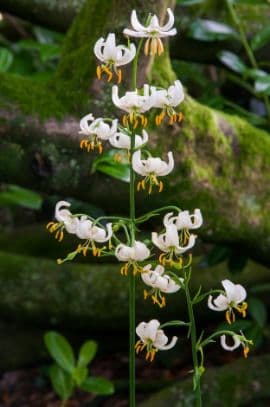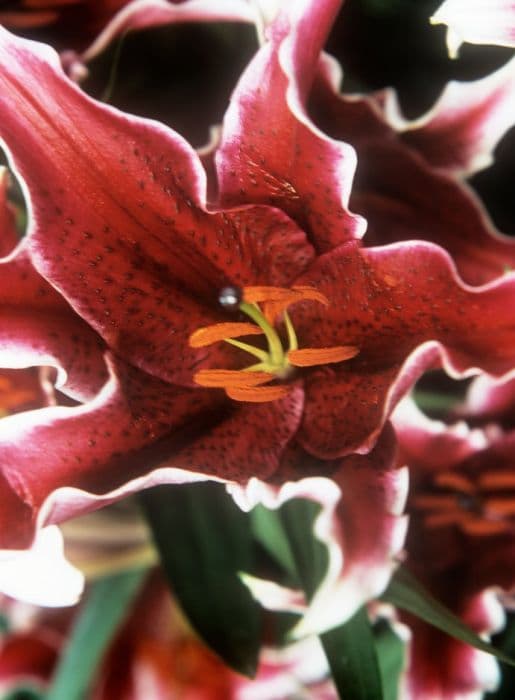Tulip Tulipa 'Candy Prince' (PBR) (1)

ABOUT
Tulipa 'Candy Prince', commonly known as the Candy Prince Tulip, is a visually striking plant that brings a soft yet vibrant allure to gardens. This particular variety showcases elegant cup-shaped flowers with petals that exhibit a delicate lilac-pink hue. The petals are smooth and almost seem to glow with a pearly sheen when they catch the light. The flowers bloom atop sturdy stems, which rise with grace and poise above the plant's foliage. The leaves of the Candy Prince Tulip are a rich green color, providing a lovely contrast to the pastel tones of the blossoms. The foliage is typically lance-shaped, with a slightly wavy or curled edge, which adds to the overall texture of the plant. In full bloom, the tulips create an enchanting display that is both romantic and eye-catching, making them a favorite for springtime gardens and floral arrangements. Their appearance is synonymous with the rejuvenation of spring, and they are often planted in groups to create swathes of color that can be seen from a distance, turning heads and capturing hearts.
About this plant
 Names
NamesFamily
Liliaceae
Synonyms
Tulip, Candy Prince Tulip
Common names
Tulipa 'Candy Prince' (PBR)
 Toxicity
ToxicityTo humans
Tulips, including the Tulipa 'Candy Prince', are not considered fatally poisonous to humans. However, eating any part of a tulip can cause symptoms such as nausea, vomiting, and diarrhea due to the presence of alkaloids like tulipalin A and tulipalin B. Ingesting tulips may also cause irritation in the mouth and throat.
To pets
Tulips are toxic to pets, particularly dogs and cats. Ingesting any part of the plant, especially the bulbs, can lead to symptoms such as drooling, nausea, vomiting, and diarrhea. In severe cases, ingestion can result in depression of the central nervous system and can cause cardiac issues and difficulty breathing. If a pet ingests tulips, it's important to consult a veterinarian immediately.
 Characteristics
CharacteristicsLife cycle
Perennials
Foliage type
Deciduous
Color of leaves
Green
Flower color
Lavender
Height
1 foot 4-6 inches (45-55 cm)
Spread
4-6 inches (10-15 cm)
Plant type
Bulb
Hardiness zones
3-8
Native area
Central Asia
Benefits
 General Benefits
General Benefits- Attractive Bloom: Tulipa 'Candy Prince' showcases beautiful pastel lavender flowers that add a touch of elegance to any garden setting.
- Spring Interest: Blooming in early to mid-spring, it provides vibrant color and interest after the winter months.
- Easy to Grow: It is known for being relatively easy to cultivate, requiring minimal maintenance, which makes it suitable for gardeners of all skill levels.
- Naturalizing: The tulip has the ability to naturalize, meaning it can spread and become more abundant over time in suitable conditions.
- Attracts Pollinators: Flowers can attract bees and other pollinators, supporting local ecosystems.
- Container Gardening: It is well-suited for pots and containers, offering flexibility for those with limited garden space.
- Robust Bulb: As a bulbous plant, it can often endure colder winter conditions by retreating underground until spring.
 Medical Properties
Medical PropertiesThis plant is not used for medical purposes.
 Air-purifying Qualities
Air-purifying QualitiesThis plant is not specifically known for air purifying qualities.
 Other Uses
Other Uses- Crafting perfume: The petals of tulips can be used in the process of making perfumes, offering a subtle floral scent.
- Natural dye source: Tulip petals, especially from vibrant varieties, can be used to create natural dyes for fabrics or paper.
- Artistic inspiration: The unique color of 'Candy Prince' tulips can serve as inspiration for artists and designers in their creative projects.
- Eco-friendly confetti: Dried petals of the tulip can be used as a biodegradable alternative to traditional confetti at events.
- Culinary decoration: Edible flowers like 'Candy Prince' tulips can add an elegant touch to salads and desserts.
- Photography subject: Due to their distinct beauty, these tulips are often used in photography to enhance visual appeal.
- Wedding decor: The soft pastel shades of 'Candy Prince' tulips make them a popular choice for wedding bouquets and venue decorations.
- Floral watercolors: The delicate hues of the 'Candy Prince' tulip lend themselves well to being used as a reference for watercolor paintings.
- Garden design: 'Candy Prince' can be used to create striking color contrasts in garden beds and borders.
- Edible garnish: Some high-end restaurants use tulip petals as an edible garnish for their aesthetic appeal and light taste.
Interesting Facts
 Feng Shui
Feng ShuiThe Tulip is not used in Feng Shui practice.
 Zodiac Sign Compitability
Zodiac Sign CompitabilityThe Tulip is not used in astrology practice.
 Plant Symbolism
Plant Symbolism- Perfect Love: Tulips, including the 'Candy Prince', often symbolize perfect, deep, or enduring love, making them a popular choice during romantic occasions like anniversaries and Valentine's Day.
- Rebirth: As spring flowers, tulips signify rebirth and renewal because they are among the first to bloom, heralding the end of winter and the start of the growing season.
- Royalty: The elegant shape and often rich colors of tulips can symbolize royalty and a regal nature, with the 'Candy Prince' variety having a particularly royal-sounding name.
- Prosperity: Historically associated with the Dutch Golden Age when they were highly valuable, tulips can represent prosperity and abundance.
- Confidence: The strong stems and upright blooms of the tulip may represent confidence and strength, with the color of 'Candy Prince' adding a gentle yet self-assured energy.
 Water
WaterTulips, including 'Candy Prince', should be watered thoroughly at planting and then not again until you see the first sprouts. Once the tulips are actively growing, keep the soil moist but not waterlogged by providing about 1 gallon of water per square foot every week, depending on the weather. Over-watering can cause bulb rot, so it's crucial to allow the soil to dry out slightly between waterings. During the flowering period, consistent moisture is important, but once the flowers have faded, you can reduce watering as the foliage begins to die back. Tulips require less water after blooming as they enter a dormant period.
 Light
LightTulips, such as 'Candy Prince', thrive best in full sunlight. They should be planted in a spot where they can receive at least 6 hours of direct sun daily. However, they can also tolerate partial shade, especially in the afternoon when the sun is the strongest. Proper light exposure is essential for the development of strong stems and vibrant blooms.
 Temperature
TemperatureTulips including the 'Candy Prince' variety, do well in a broad range of temperatures. They need a period of cold dormancy, which is why they are planted in the fall. They can survive winter temperatures well below freezing, but the ideal growing temperature once they start to sprout is between 60°F and 70°F during the day and slightly cooler at night. Once established, they can tolerate spring temperatures up to 75°F but should be protected from extreme heat.
 Pruning
PruningPruning is not typically necessary for 'Candy Prince' tulips. However, after flowering, it is recommended to deadhead the plant by removing the spent flower heads to prevent seed production. Leave the foliage in place until it turns yellow and can be removed easily—this is when the tulip's leaves are no longer photosynthesizing and conveying energy to the bulb for the next year. The best time for deadheading is soon after the blooms have faded.
 Cleaning
CleaningNot needed
 Soil
SoilTulips thrive in a well-draining, fertile soil with a neutral to slightly acidic pH of around 6.0 to 7.0. The best soil mix for 'Candy Prince' tulips consists of one-third garden soil, one-third compost or well-rotted manure, and one-third sharp sand or grit to improve drainage. Ensure the soil is light and does not hold water to prevent bulb rot.
 Repotting
RepottingTulips including 'Candy Prince' do not require frequent repotting as they grow from bulbs that are to be planted annually. Rather than repotting, tulip bulbs should be lifted after the foliage has died back and stored in a cool, dry place to be planted again in the fall.
 Humidity & Misting
Humidity & MistingTulips such as 'Candy Prince' are not particularly sensitive to humidity levels; average outdoor humidity suits them well. They do not need specific humidity control if grown in their preferred climate and outdoor conditions.
 Suitable locations
Suitable locationsIndoor
Place Candy Prince tulip bulbs in pots with drainage holes and direct sunlight.
Outdoor
Plant bulbs in Autumn in well-draining soil; full sun to partial shade.
Hardiness zone
3-8 USDA
 Life cycle
Life cycleTulipa 'Candy Prince', commonly referred to as the Candy Prince Tulip, starts its life as a bulb planted in the fall before the first frost. During winter, it undergoes a period of dormancy, which is crucial for the development of the flower. With the arrival of spring, the bulb breaks dormancy, sending up shoots that develop into stems and leaves. Following this, the distinctive lavender-pink flowers bloom in mid to late spring, offering a spectacular display. After the blooms have faded, the plant enters a period where it stores energy in the bulb for the next season, eventually withering above ground by early summer. The cycle repeats the following year, with the bulb lying dormant again until the next growth period.
 Propogation
PropogationPropogation time
Spring
The most popular method of propagation for the Tulip 'Candy Prince' is through the division of its bulbs. Bulb division is typically done in the fall, after the foliage has died back and the bulbs have completed their dormancy period. Gardeners should carefully dig up the bulbs, being cautious not to damage them, and gently separate the offset bulbs that have formed around the base of the mother bulb. These offsets, or daughter bulbs, should have some roots attached and can be replanted immediately at a depth of about 6 to 8 inches (15 to 20 centimeters) apart in well-draining soil, ensuring that the pointy end of the bulb is facing upwards. By the following spring, these newly planted bulbs will likely have established themselves and will be ready to produce the characteristic blooms of Tulip 'Candy Prince'.






![Lily [Roselily Chelsea]](/_next/image?url=https%3A%2F%2Fplants-admin.emdemapps.com%2Fimages%2Fplants%2F%2Fimages%2F604b584f6f830.png&w=640&q=75)


